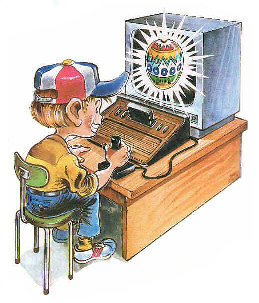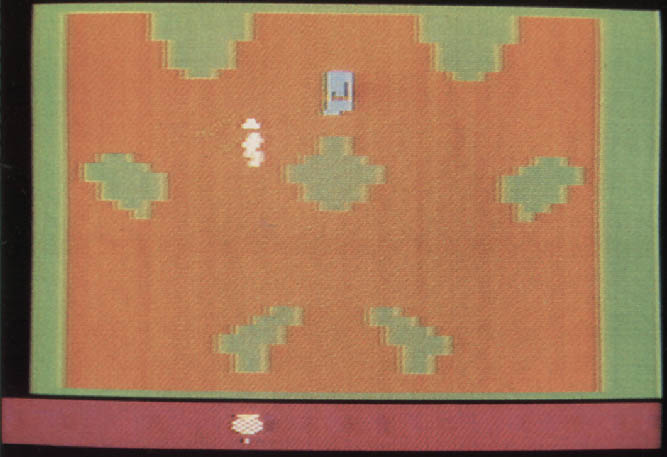

Easter Egg Hunting with Bill Kunkel and Joyce Worley
By Scott Stilphen
(2000)

For those who are really into “old school” gaming, shows like the Classic Gaming Expo is the closest thing you can find, returning you to those seemingly endless days of video gaming – armed with only a single fire button and some archaic mono sound, 13-channel, analog-tuned TV. One positive benefit of taking this trip back now is getting to meet those who, whether we realized it or not, had a major influence on us. Bill “Game Doctor” Kunkel and Joyce Worley are two such people that I had the opportunity to talk with, thanks in part to the CGE. Since the subject of Easter eggs has always interested me, I decided to turn to the founders of Electronic Games magazine and ask them their thoughts on the subject.

Q: In regards to Easter eggs, it was the magazine’s policy to let readers know when a game contained one, but not to reveal how to find them. Occasionally though, you did print letters from readers asking about them, so I’m curious to know if you’ve kept any information regarding these tricks on file over the years.
Bill Kunkel: Honestly, we never really thought people would even remember Easter eggs by the turn of the century, much less care about them :) To us, it was an amusing element of the hobby, but we didn’t usually reveal the secrets (just as we generally avoided specific strategy codes or things like that, since we felt that finding them was most of the fun). Also, we didn’t get to keep any of the editorial materials from the original EG, so whatever stuff there was is probably long gone.
Q: There are many collectors and players (including myself) who are quite interested in these, and we believe there are still a number of these that have still not been found to this day. I’d like to point to a few examples from past issues. One such letter (show at right) appeared in the January ’84 issue (page 8), which mentioned the existence of some hidden eggs in E.T. (Atari VCS/2600). Is (or was) the author’s identity truly unknown? The “pair of initials in the upper right-hand corner” have never been found. This is thought to be the initials of the game’s graphics artist, Jerome Domurat.
Bill Kunkel: The author of that letter was a real person, and I believe he was someone connected with Atari who was feeding us stuff. Sometimes, however, Atari found out about plans to inject Easter eggs (in the games) and nixed them.
Q: Ah, I suspected something like that! The letter has an “adult” tone to it. The fact that it might have come from someone associated with Atari makes sense, since the writer refers to “… programmers” (as you know, most games at the time were written by one person. E.T. was, at the time, one of the rare exceptions in that two people worked on it). I figured if it was merely some “kid”, they would have explained how it was done (for bragging rights), and the fact that the eggs are not easily found would have meant they played the game quite a bit, which wouldn’t be the case if they thought the game was a “dud”. From the accompanying photo, a Crazy Climber cartridge is pictured (a tough game to find even back then, as it was only available directly from Atari via their Atari Age magazine) and the E.T. doll could be a nice touch to convince someone the letter was from a kid. I suppose there’s even a chance that either Jerome or Howard Scott Warshaw wrote the letter, or were somehow involved! Then again, maybe I’ve been over-analyzing this letter for too long… :)
Another instance appeared in the November 1982 issue (page 24). The picture (shown below) of Raiders of the Lost Ark (Atari VCS/2600) shows Jerome Domurat’s “graphic signature”. The same picture appeared again in the March ’84 issue, as well in several other publications (magazines and books), which leads me to believe that this was either a photo supplied by Atari, or one that EG took.
Bill Kunkel: The picture in question was supplied by Atari. Many of the “screen shots” or “playfields” that companies produced in those days were not photos but were artist recreations of the basic screen so they could show off all the elements – and because it was still damned tough to get good screen photos from a TV (Ed: It should be noted that the picture in question is an actual screen shot).
Q: In the 1st issue of EG (Winter 1981), Atari’s Steve Wright stated, "From now on, we're going to plant little 'Easter eggs' like that in the games. Eventually, we may have a real treasure hunt, with the clues hidden in various cartridges!". As far as I know this was the 1st time that term was used. Did Steve coin the term or was it used earlier (perhaps in one of the "Arcade Alley" columns)?
Bill Kunkel: To the best of my memory, Arnie Katz coined the term “Easter egg” but I wouldn’t swear to that.
Regarding the creation of them, Atari did several turnarounds on the Easter egg thing. First they were pissed off, but then when the positive public reaction came in, they kind of went overboard in the other direction and I think they became less anal about installing them in every game.
Q: Based on Steve Wright’s statement, here’s a complete (?) list of Atari’s 1982 VCS titles. The “*” denotes which games have been found to contain a hidden surprise:
3-D Rubik's Cube (not released)
Berzerk
Combat Two (not released)
*Defender
Demons to Diamonds
*E.T.
Frog Pond (not released)
Galaxian
Haunted House
Math Gran Prix
Pac-Man
Racer (not released)
*Raiders of the Lost Ark
RealSports Baseball
RealSports Football
*RealSports Volleyball
Star Raiders
Submarine Commander
Super Breakout
SwordQuest EarthWorld
*Yars’ Revenge
Just from this small list, you can see there’s only a few titles that are known to have any. I’m not sure if this was just a marketing strategy to sell more games, or if in fact Steve was serious.
Bill Kunkel: I’m sure Steve intended to plant stuff in all those games, but the 2600 started dying around that time and a LOT of plans were scrapped at the last minute and I’m sure inserting Easter eggs took a very low priority (Ed.: Hardly. The VCS was extremely popular throughout 1982. Also, Howard Scott Warshaw included Easter eggs in both Raiders of the Lost Ark and E.T., which were both released in November of that year).
Joyce Worley: Easter eggs are an interesting topic. At one time, as Steve Wright indicated, almost every video game had at least one little “extra”, whether it was only the programmer’s initials, or entire scenarios. Sometimes the companies knew; most times, they did not.
Q: Do you have any anecdotes with Steve?
Bill Kunkel: Steve was a great guy who programmed Pele’s (Championship) Soccer for the 2600 and was the first person to do vertical scrolling. He told me, “One of the head programmers asked what I was doing and I said a vertically-scrolling soccer game and he said, ‘You can’t’ do a good vertical scroll on the 2600.’ I’m glad he waited to tell me because by then I had already done it!”
They (Atari) moved him from development into a more high-profile position. He appeared on a Today show once with Arnie. And I have no idea what became of him, but he was a cool guy with a great empathy for the gamers.
Q: How do you feel about the evolution of eggs in today’s games?
Bill Kunkel: As happens with these traditions, they get more and more layers of technicality thrown on top of them until it becomes a self-conscious big deal. It was much more fun when it was just innocent jesting
Joyce Worley: The practice sort of died away after some programmers went too far, putting in sequences that were contrary to the image the company wanted to present. As I am sure you know, some were nothing more serious that a (figuratively speaking) wink of the eye by the programmer. Others delivered political or sexual scenes. The necessity of recalling a game or two (at great expense) made the companies less forgiving of these programming inventions.

The infamous screen photo of Jerome M. Domurat’s initials (shown as a graphic “logo”) in Raiders of the Lost Ark's Valley of Poison appeared in several publications in at least 5 separate instances: Consumer’s Guide book, How to Win at Home Video Games, (page 56), Electronic Games (November 1982, page 8), Electronic Games (March 1984, page 24 - picture is upside-down), Videogaming Illustrated (December 1982, page 59), Joystik (November 1982, page 5 – picture is flipped horizontally), and in the book, Video Spelletjes - complete handleiding voor winnaars, (by Arnie Katz, Bill Kunkel and Kees van Toorn, page 52). For reasons unknown, this graphic was removed in the released version, although a prototype version with it might still exist somewhere.